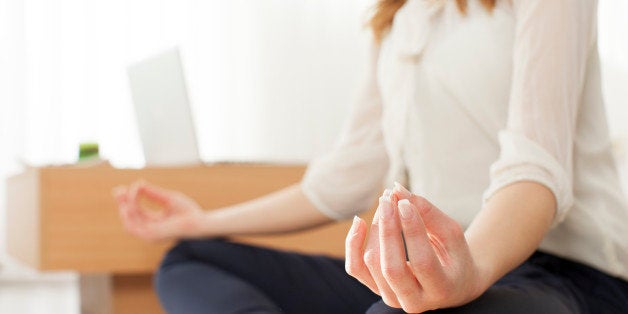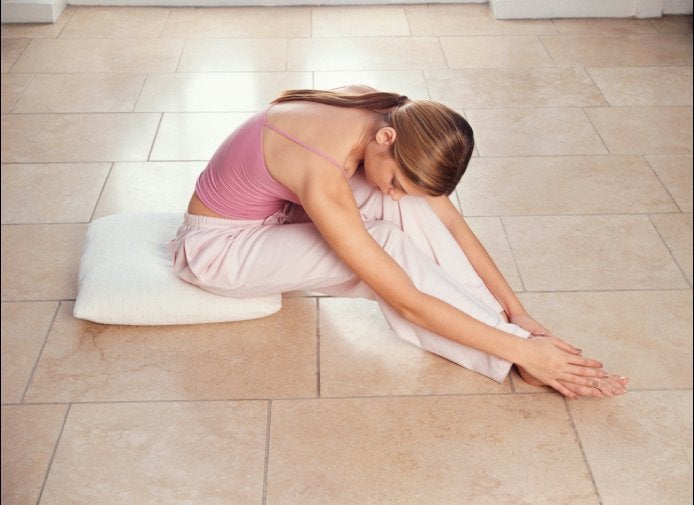
This post is part of Stress-Less Parenting Club's latest workshop. Our leader Carla Naumburg is showing us how we can make our family life calmer and happier through mindful parenting.
I will never forget the first time I tried to meditate. I was sitting on a hard floor in a stinky gymnasium, hoping to score an easy PE credit so I could graduate from college. A tall, thin man dressed all in white with a long, wispy beard instructed us to cross our legs, close our eyes, breathe deeply and clear our minds.
I was able to cross my legs, but it all went downhill from there.
Clear my mind? What the hell did that mean? Every time I tried to clear my mind, I realized I was just thinking about clearing my mind, which clearly isn’t the same thing. I tried thinking about black. I visualized black. But then I thought about how black isn’t my favorite color; I prefer blue but I can’t decide between sapphire or turquoise… and the next thing I knew, my mind was anything but clear. Also, my butt hurt from sitting on a hard floor, my nose itched, and I wasn’t sure if I should scratch it.
I didn’t try meditation again for almost 20 years.
Fast forward to parenthood. You know my story: I was yelling too much and I wanted to find a way to stay calm through the chaos of tantrums and whining and kids not listening. I did not want to meditate. But I was desperate, and everything I read about how to be kinder and less reactive pointed to meditation. Against my better judgment (at the time), I signed up for a mindfulness-based stress reduction course.
Here is what I learned about meditation:
1. You don’t have to sit cross-legged on the floor to meditate. You can sit in a chair or on a meditation cushion or bench -- or you can lie down or walk. You can be comfortable.
2. You don’t have to close your eyes.
3. You don’t have to clear your mind. Far from it.
4. Meditation isn’t about staying perfectly focused on your breath or a candle or a mantra. It’s about noticing when your mind has strayed and coming back, over and over again. Even seasoned meditators have a hard time staying focused.
5. How you feel during your meditation session is not an indication of how successful or unsuccessful it was. How you feel after you meditate is much more important.
I try to meditate for about 20 minutes at a time, several times a week. Please note, I said try. It doesn’t happen every day for me, and it certainly doesn’t have to happen every day for you. But meditation is dose dependent, meaning the more you do it, the more you will experience its benefits, such as decreased stress and reactivity (i.e. you’ll be less likely to explode at your kids), improved sleep and better moods.
So, if you’re ready to give it a shot, here’s what you need to do:
Sit down and breathe.
Here’s how:
Find a comfortable sitting position, either on a chair or on a cushion. If you’re in a chair, sit with both feet on the floor. You can also lie down, and if you find yourself falling asleep, enjoy the nap. Next time, try keeping your eyes open.
Take a few deep breaths to start, and then let your breathing steady out to however your body wants to breathe. You don’t have to breathe slowly or deeply, just breathe normally. Pay attention to your breath, either at your nostrils or at your belly. You can say quietly “in, out, in, out” with each breath, or you can count your breaths, and when you get to 10, start again at one.
When your mind wanders, as it will after about three seconds, just gently go back to your breathing. Try not to get frustrated with yourself; your mind is just doing what it is used to doing -- thinking! Just notice your thoughts, whatever they are, let them go, and go back to your breath. And then do it again, and again.
If 20 minutes seems like a long time, try 10. Or two. Any amount of time is better than none. You can use a kitchen timer, a digital watch or any one of the apps listed below to help you.
THIS WEEK'S CHALLENGE
1. Keep going with the challenges from the previous weeks: try to notice when you’re physically but not mentally present with your children, and find times each day to practice mindfulness.
2. Try meditating! My favorite meditation apps for iPhone and Android are the Insight Timer, Buddhify and HeadSpace. There are a lot of options, so do a little exploring to find one you like.
If you have questions about meditation (or anything else!), tweet me at @SWMama or post a question on my Facebook page. Join me next week for tips on teaching mindfulness to our children.
Haven't joined our Stress-Less Parenting Club yet? Go to the purple box on the right side of this page to sign up and receive our weekly newsletter.
